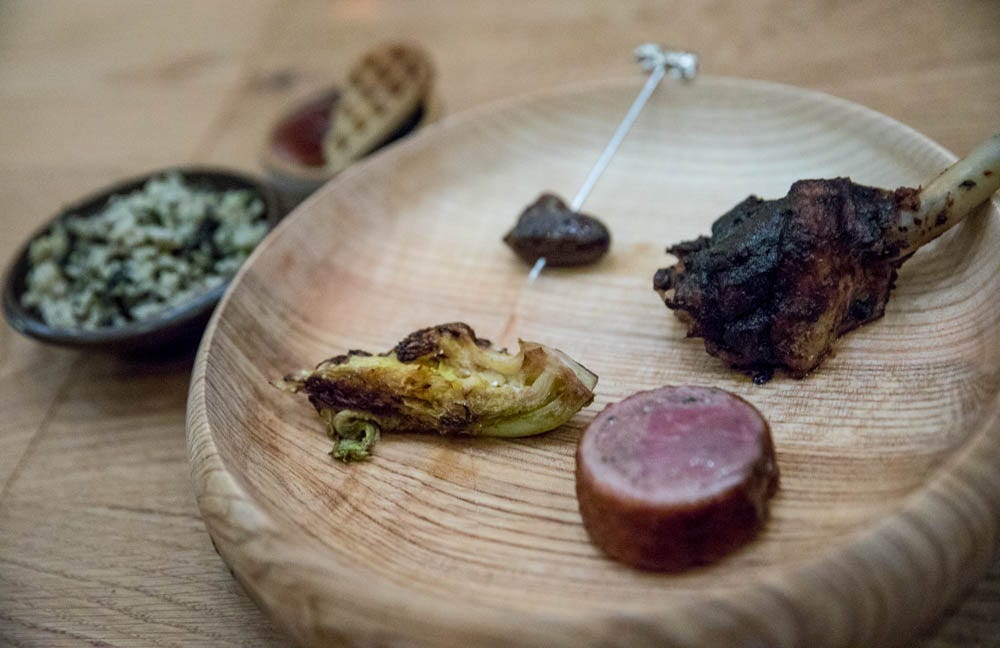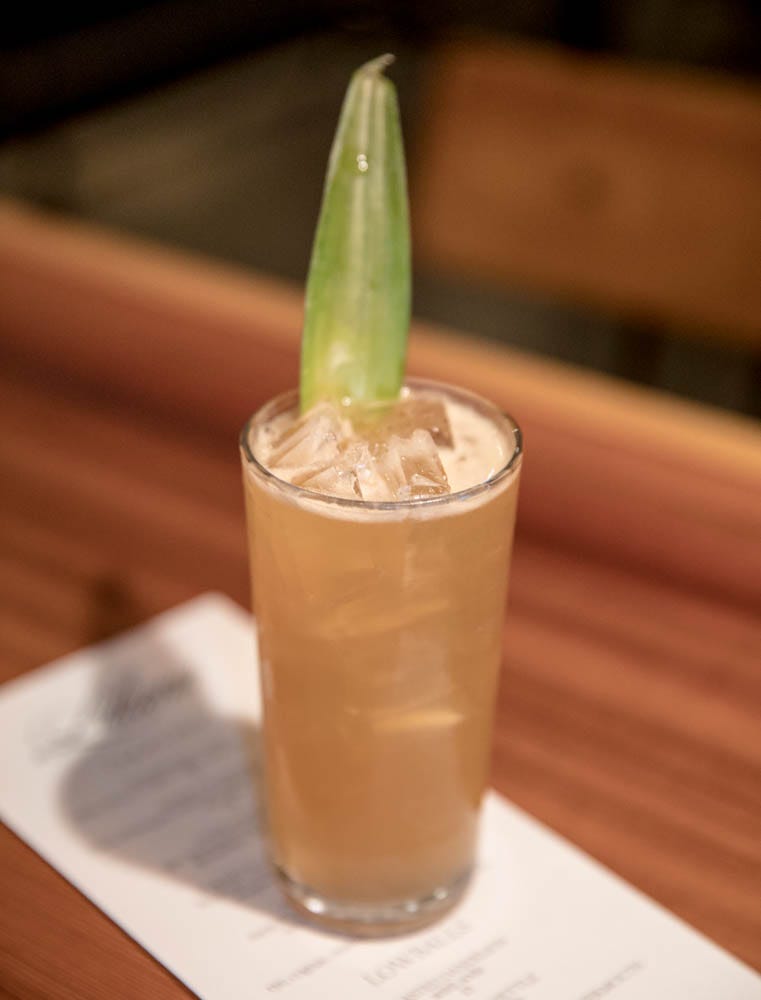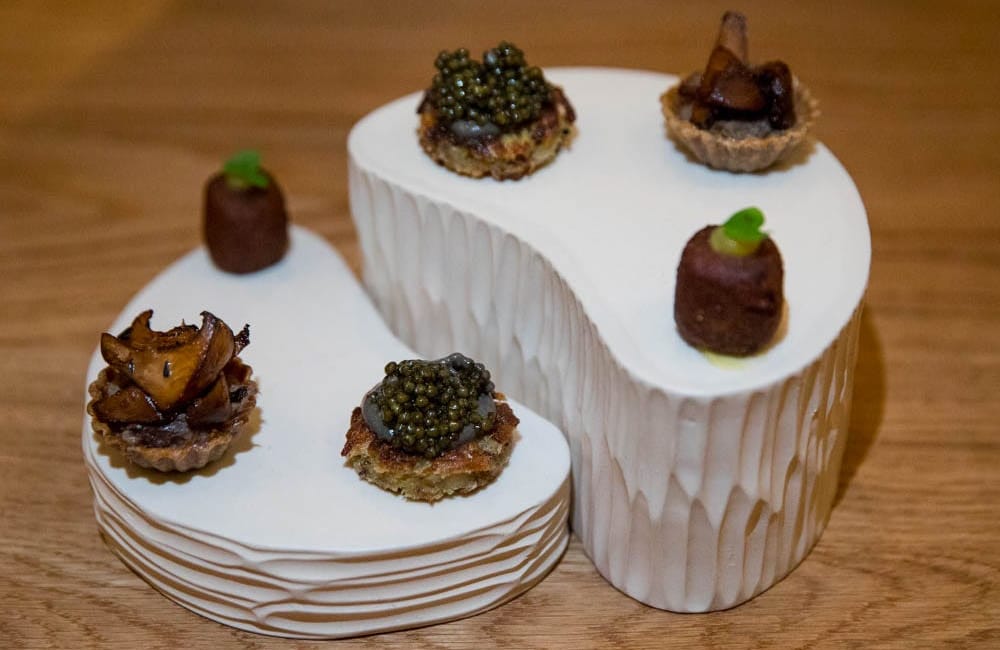Two years in the works, a restaurant as ambitious as Osito is a daunting task, especially when those two years are pandemic. Just opened late December 2021, chef Seth Stowaway’s first restaurant has crowd-sourced investors, a labor of love tested in pop-ups, where people can invest at all levels (even as little as $10). From the get-go, this, the warm service and space makes it feel communal and unified.
In fact, walking in on a pristine early January night as a fiery sunset illumined neighboring Heath Ceramics’ neon sign, the space oozed warmth from repurposed redwood and sustainably-harvested sugar pine. Cocktail bar Liliana is to the left of the entrance, while to the right, the Studio Terpeluk-designed, wood-lined dining room sports greenery and plants facing an open kitchen. At one long communal table under striking custom brass chandeliers, it already felt like a Michelin-level experience with a tight, attentive team.
I must say, it was sweet to dine at a communal table again, though nicely spaced out. Over the years, I’ve dined at many a live-fire restaurant, whether a lackluster experience at the famed Burnt Ends in Singapore, or underrated, innovative tasting menus at SF’s (recently reopened) Gibson pre-pandemic. So though open flame cooking is not a new trend, I’ve never experienced it quite like Osito, San Francisco’s only 100%, live-fire restaurant sans microwaves or burners. The wood-burning oven and hearth, custom-built by blacksmith Jorgen Harle, are fueled with almond and oak wood.

With two nightly seatings (5 and 8:30pm) and $295 per person (plus tax and gratuity) plus optional wine pairing ($105) or reserve wine pairing ($155), this is a splurge. But let’s talk about why, even in a city rife with the most three Michelin-starred restaurants in the nation, this is yet another unique SF fine dining experience that pushes boundaries.
All this becomes more impressive when you realize it’s Stowaway’s first restaurant. South Texas is where he grew up cooking outdoors, eventually moving to SF where over the past 15 years, he has been sous chef at Michelin-starred Mister Jiu’s and executive chef of Bar Agricole Group. I’ve experienced excellent service and wine pairings from his team over the years: wine director Maz Naba (whose resume includes Coi, Rich Table and Nico), director of operations Lucia Camarda (formerly at Flour + Water Hospitality Group), beverage director Jon Prange (formerly Almond and Oak and Wildhawk) and service director Madison Michael (previously at Merchant Roots).
Husband Dan and I hit the opening menu, focused on winter game birds, while February moves into local seafood (reservations at Tock). I pretty much live for seafood but game birds aren’t showcased enough, especially as a whole menu, and this one was full of surprises.
First, we started with cocktails in the aforementioned Liliana. I didn’t get to sample chef de cuisine Bethany Hunt’s dishes at the bar since I was staying hungry for Osito’s multi-course feast, but was intrigued by a bar menu of elevated dishes like kanpachi in almond milk, melon vinegar and chilis, or local Dungeness crab graced with herbs, chicories, blood orange and anchovies.

Already running into people we knew at the bar, the wood-lined haven felt familial. Foreign Affair was the best of the initial three drinks I tried, spirituous yet subtle and elegant, the softly-pink tinged drink served in a Nick & Nora glass showcasing its mezcal and sotol (Mexican desert spoon shrub spirit) base, dry with white vermouth, Cocchi Americano Rosa and a whisper of absinthe. Housemade liqueurs form the base of low proof Lowballs, like a house roasted dandelion or toasted nettle spirit topped with soda.
Post-drinks, we were escorted to the dining room with a little bourbon-Aperol welcome cocktail. Though there are technically nine courses including mignardises (dessert bites), some courses contain three elements or different parts of the animal, so it felt like a lot more. Whole animal use always makes me grateful, while ubiquitous local produce and ingredients gave way to house pickled, fermented and preserved foods.

A trio of bites arrives first, artfully displayed on locally-made plateware. While a game bird mushroom chestnut tartlet is savory delight, a masa ball of fermented bean, rillettes and finger limes gelee on top tasted like Mexico with a twist. A little sweet potato cake throws traditional blini on its head topped, yes, with Tsar Nicoulai caviar, but over a layer of soured cream and fermented huitlacoche (corn smut or fungus to you), resulting in an earthy, briny bite of heaven. Paired with a lean, no-oak 2019 Altesse Famille Peillot Roussette du Bugey from old vines in Saovie, France, the wine’s acidity brightens up the rootsy gratification of the three bites.
Jumping ahead, the third course — another trio, this time of guinea hen — was the showstopper of the night, singing with Naba’s pairing of crisp 2017 Guy de Forez Ricey’s Pinot Noir Rose Champagne. Cured guinea hen was like an aged fish with a bit of chew and sashimi-esque delicacy, cured in hazelnut oil, dotted with rehydrated fig jam. From texture to flavor, I marveled that this was a hen. A juicy round of guinea hen-abalone sausage was partnered with apple pine puree. This is the kind of sausage I’d never had and didn’t know I needed. Guinea hen tartare especially thrilled, recalling silky seafood tartare or raw chicken sashimi in Japan (served locally at Ippuku in Berkeley). Accented with quince and hot mustard in almond milk, the cool, textured tartare was truly a “wow” moment. Over 12,000 restaurants around the world later, it’s very rare I have something I’ve never tasted in just such a way. This is that kind of dish.
A brassicas course (in this case, Romanesco broccoli) is seriously “goosed up” (forgive the pun) with one of my Piedmont, Italy faves: bagna càuda (hot garlic and anchovies) — and Stowaway’s “fowl floss,” recalling Chinese pork floss in the style he made it at Mister Jiu’s, fraying into sweet, savory threads.

A main course of roast duck comes in multiple bites with a side of brown rice laced with wild mushrooms and fermented greens, plus braised cabbage in whey. A round of rare roast duck utilizes a fave flavor combo — orange and chocolate — with preserved mandarin and cocoa. Duck liver pate in brandied cherries is scooped up with a tiny waffle. A tender duck heart is contrasted by salted plum. It’s hard to top the juicy duck wing, however, blessedly umami-sweet in a glaze of medjool date, black garlic and pomegranate. A wine pairing of a rare 2015 Nusserhof Elda Schiava red wine blend from my beloved Northern Italian region of Alto Adige (where I’ve been privileged to travel through three times), complements this course with balanced acidity, red fruit and earthiness.
Naba pairs an icy-cool palate cleanser of pear and nettles with a zippy, sweet, creamy-yet-lean Harushika Tokimeki Nama Chozo Junmai sake (nama being the fresh, unpasteurized category of sake I am long crazy about), while a California winter dessert of persimmon, honey and candy cap mushroom ends the feast.
The glow of the room and staff and the nurture of one of the most inspired series of game meats I’ve ever tasted encompassed us as we headed home. I promptly began plotting how I could save up and find time in the schedule to hit up their seafood menu — and the spring vegetable menu after that. Welcome, Osito. It was worth the wait.







